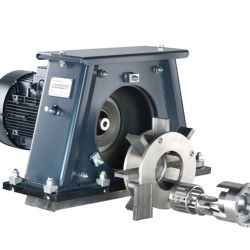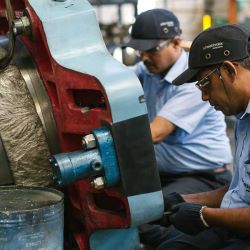How to make mean machines go lean
When we started our lean journey here at Titan Steel Wheels, everyone thought our shot blast machines were basically incorrigible. The downtime caused by these four old troopers was taken as an unchangeable fact of life – even though it was constantly causing issues across production.
We had to challenge this mindset and then go and prove everyone wrong – by tackling the ultimate maintenance challenge: making our shot blast equipment run like clockwork.
Measure everything – but don’t add admin
To convince the production guys to give us time for maintenance, to make the business case for getting experts in, and to track progress, we had to know how the machines were doing. We had to capture when, where, for how long and why equipment was breaking down. This is not new, most people capture this sort of thing – but it’s usually done on a piece of paper on the shop floor and then entered into a system elsewhere, by someone else.
We decided to invest in some basic (and rugged!) smartphones for everyone on the shop floor and developed a simple app that allows them to input data at the point of use. This way, we’re constantly creating a live picture of operations in real time, which is visible to everyone and encouraging problem solving. For our shot blast equipment, it allowed us to show that investing in and making time for maintenance would potentially give us back 75 hours of machine uptime across the four machines every week.
Incentivise your people to get to the root of the problem – make it easy
Putting the guys on the shop floor in charge of tracking when problems occur, how they develop and how they are solved, immediately focuses everyone on looking for root causes rather than quick fixes. Because everyone can see what’s happening, it pays to go through the “5 Whys” and get to the bottom of the problem, rather than allow an issue to recur.
The transparency created by the new system has empowered people to do the right thing, because they can prove it’s worth it. On top of that, we’re running prize draws across suggestions coming from the shop floor, which further incentivises continuous improvement.
Learn from the experts – and give them something to work with
The fact that we’re getting the full picture of equipment performance means that any conversation with the team from Wheelabrator, who help us with maintenance and service of our shot blast machines, starts on a very informed basis. We can give them a lot of data and analysis when they come in, allowing us to skip a couple of steps and make the best use of their expertise.
For our maintenance teams, these conversations are important opportunities to learn and we’re encouraging knowledge transfer from Wheelabrator’s experts to our generalists. The better our team understand the specific needs of shot blast equipment, the better our safety net when something goes wrong, and the better we can look after machines during normal operations.
Build a system that self-heals – and make it flexible
And finally, it may sound obvious, but if you’ve got machines that self-destruct, build a system around them that allows “self-healing”. What this means is, that we can set automatic triggers on our system for specific maintenance measures, capturing issues early.
For example, instances of downtime on an individual machine that exceed a certain number of hours will automatically trigger a priority service and special inspection. Thanks to the data to hand and our ongoing learning, we can adjust these trigger values and fine-tune the measures taken in response.
This flexibility in the set-up means we can, over time, completely align the breakdown behaviour of our equipment with the preventative maintenance programme in place. The ultimate goal: eliminate downtime completely. That’s the vision we’re working to. We need our shot blast equipment to run all the time, so we’re going to make that happen. At 4.5 hours average combined downtime per week, we’re nearly there!
Guest post written by
Jake Higley
Lean Manufacturing Manager, Titan Steel Wheels, Kidderminster, UK


